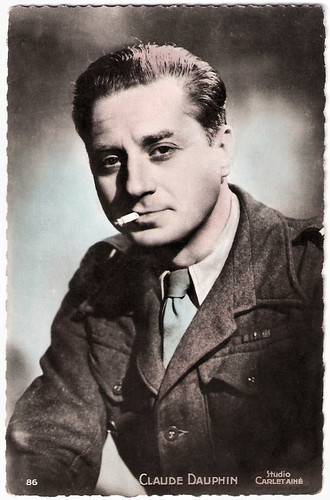
French postcard by Editions P.I., Paris, no. 86. Photo: Studio Carlet Ainé, Paris.
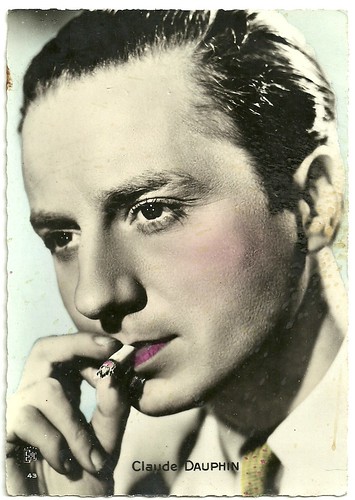
French postcard by EPC (Editions et Publications Cinématographiques), no. 43.

Small collectors card, Serie D, no. 30. Photo: Warner Bros. Publicity still for April in Paris (David Butler, 1952).

French postcard by Editions P.I., Paris, no. 86. Photo: Studio Carlet Ainé, Paris.
The world will shake
Claude Dauphin was born as Claude Marie Eugène Legrand in Corbeil-Essonnes, France, in 1903. He was born into a family of French music hall entertainers. His father was Maurice Étienne Legrand, a poet who wrote under the name of Franc-Nohain, and who was the librettist for Maurice Ravel's opera 'L'heure espagnole'. His brother would become the actor Jean Nohain.
Claude made his own entree into the theatrical world as a set designer. The prematurely greying Dauphin turned to acting in the late 1920s, and he made his stage debut in a play by Tristan Bernard. His first film appearance was in the comedy-drama La Fortune/The Fortune (Jean Hémard, 1931) opposite Alice Tissot. During the 1930s, he appeared in several not-very-remarkable films, including La fille du regiment/The Girl of the Regiment (Pierre Billon, Carl Lamac, 1933) with Anny Ondra, La route heureuse/The Happy Road (Georges Lacombe, 1935) starring Edwige Feuillère, Faisons un rêve.../Let Us Do a Dream (Sacha Guitry, 1936) and Entree des Artistes/Artists Entrance (Marc Allégret, 1938) with Louis Jouvet.
He had his breakthrough in the Science-Fiction film Le monde tremblera/The World Will Shake (Richard Pottier, 1939) based on a screenplay by Henri-Georges Clouzot. Dauphin played the lead role of Jean Durand, a young scientist who has invented a machine that can tell you how many years, days, hours and minutes you have left to live. Clouzot's touch can be felt in the scientist character: from the first sequence we know he is a very cynical man, despite his nice looks: he tries to use a prostitute as a guinea pig to test the machine.
Next, Dauphin played in the Jean Anouilh adaptation Cavalcade D'Amour/Love Cavalcade (Raymond Bernard, 1940) three leading parts (Léandre, Hubert and Georges) in three romances occurring within the walls of the Chateau de Champs. In the romantic comedy Battement De Coeur/Heart Throbs (Henri Decoin, 1940) he starred as Pierre opposite Danielle Darrieux. At AllMovie, Hal Erickson writes: “Dauphin nearly always managed to elevate his material with his shameless scene-stealing and Boulevardier charm.”
At dawn, the day after the end of the filming of La belle aventure/Twilight (Marc Allégret, 1942) with Micheline Presle and Louis Jourdan, he embarked aboard a British submarine in Nice bound for Great Britain. La belle aventure was banned in 1943 by the German Occupation authorities because Dauphin had by then joined the F.F.L. (French Liberation Forces). In Great Britain, he starred opposite Michael Wilding and Lilli Palmer in English without Tears/Her Man Gilbey (Harold French, 1943).

French postcard, no. 557. Photo: Studio Piaz, Paris.
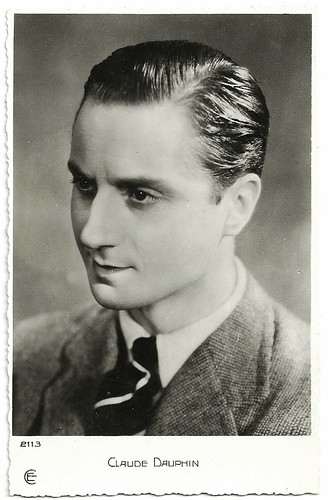
French postcard by Edition Cinémagazine, no. 2113.
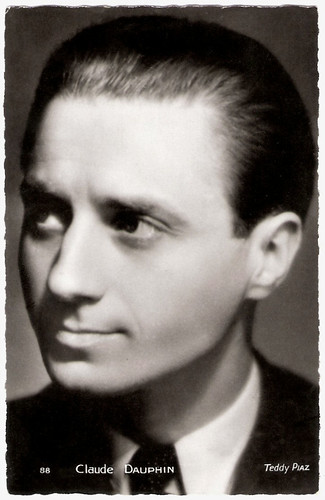
French postcard by O.P., Paris, no. 88. Photo: Teddy Piaz.
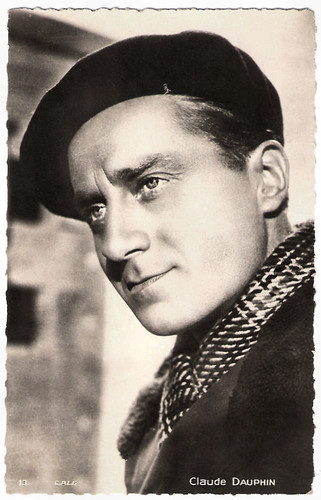
French postcard by E.C. (Europe Cinema), Paris, no. 13. Photo: C.A.L.F.

French postcard by Editions Chantal, Paris, no. 557. Photo: X...
The most important thing: love
Back in France, Claude Dauphin played Cyrano de Bergerac (Fernand Rivers, 1945). IMDb user mla195 writes: “Overall this is an average post-war French production with minimal settings are inexistent cinematography, except some fine and well-taken cartoons accompanying Cyrano's description of his space travels. It nevertheless remains pleasant to watch thanks to the magic of the play and the outstanding performance of Claude Dauphin in Cyrano.” Dauphin also worked again with Micheline Presle and Louis Jourdan in Félicie Nanteuil (Yves Allégret, 1945). In 1950 he made his Hollywood debut in the crime drama Deported (Robert Siodmak, 1950) starring Jeff Chandler. In 1952 he was the film partner both of Doris Day in April in Paris (David Butler, 1952), and of Claire Bloom in Innocents in Paris (Gordon Parry, 1952).
In France, he starred opposite Simone Signoret in Casque d’Or/Golden Helmet (Jacques Becker, 1952). The following year he appeared in Le Plaisir/House of Pleasure (Max Ophüls, 1952) based on three stories by Guy de Maupassant. Broadway audiences were regaled by Dauphin in the original stage version of The Happy Time. Dauphin co-starred with Louis Jourdan in the European-filmed TV series Paris Precinct (1953-1955) about two Paris police detectives, one older and more experienced and one young and eager, who track down criminals and solve crimes. His later television work included several sparkling guest appearances on the American late-night Merv Griffin Show.
In the cinema, he was seen in the adaptation of Graham Greene's prophetic novel about US foreign policy failure in pre-war Indochina, The Quiet American (Joseph L. Mankiewicz, 1958) starring Audie Murphy. His films of the 1960s include the first film directed by Costa-Gravas, Compartiment Tueurs/The Sleeping Car Murders (1965), the all-star war epic Paris Brule-t-il?/Is Paris Burning? (René Clement, 1966), the romantic comedy Two for the Road (Stanley Donen, 1966) starring Albert Finney and Audrey Hepburn, and the science fiction send-up Barbarella (Roger Vadim, 1968) featuring Jane Fonda as an interstellar representative of the united Earth government.
Dauphin continued to play in interesting films. He appeared in L’Important c’est d’aimer/That Most Important Thing: Love (Andrzej Zulawski, 1975) starring Romy Schneider. Yuri German writes at All Movie: “Set in a world of losers and futile talents, this dark and moody drama depicts love as the only source of salvation. Memorable performances and skilful direction make this film a powerful experience.” The next year, Dauphin appeared again with Schneider in the psychological drama Mado (Claude Sautet, 1976).
That same year director Roman Polanski cast him in his psychological thriller The Tenant (1976). Another highlight was his reunion with Simone Signoret in La Vie devant soi/Madame Rosa (Moshe Mizrahi, 1977) based on a novel by Emile Ajar (better known as Romaine Gary). Dauphin's last film was the TV production Les Miserables (Glenn Jordan, 1979). Claude Dauphin died in 1978 in Paris of intestinal occlusion. He was married three times, to the actresses Rosine Deréan, Maria Mauban, and Norma Eberhardt. With Mauban he had a son, actor Jean-Claude Dauphin (1948). He was also the father of Antonia Dauphin, from his relationship with Ruda Michelle.

French postcard by SERP, Paris, no. 5. Photo: Studio Harcourt.
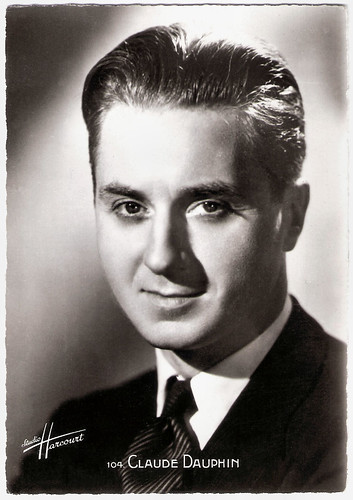
French postcard by Greff Editeur, Paris, no. 104. Photo: Studio Harcourt.
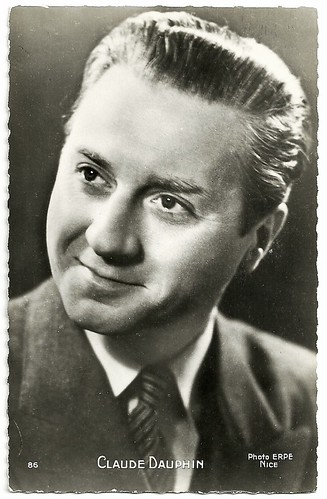
French postcard by Editions P.I., Paris, no. 86. Photo: Erpe, Nice.
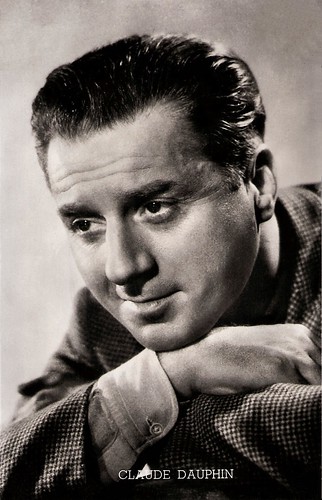
French postcard, no. 153.
Doris Day and Claude Dauphin in April in Paris (1952). Source: Ann Daed (YouTube).
Trailer for Barbarella (1968). Source: Lost Boy (YouTube).
Sources: Hal Erickson (AllMovie), Yuri German (AllMovie), Wikipedia, and IMDb.
This post was last updated on 30 November 2023.
No comments:
Post a Comment